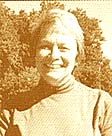2001-2002
The Archaeology and History of Cultural Landscapes
Cultural landscapes are the perceived settings in which human events and circumstances are experienced. They consist of places altered to suit human needs along with places left unchanged but recognized for important qualities. Cultural landscapes influence and reflect the personal, social, political, economic, religious, and mythic dimensions of human knowledge.
Anthropologists, archaeologists, geographers, historians, and many others in recent years have discovered that the study of cultural landscapes, past and present, may reveal new insights concerning the organization and development of human communities and their relationships with the environment. As people act on the potentialities offered by their environments, they transform their surroundings and encode in the terrain such diverse qualities as knowledge and belief systems, social and political orders, land use patterns, community identities, and relationships with other groups.
The variable perspectives that accompany the study of cultural landscapes, from site to region and from individual to community, make use of new methods and techniques. Remote sensing from orbiting satellites, archaeogeographical prospecting using technologies such as ground penetrating radar, locational plotting using global positioning systems (GPS), and the application of geographic information systems (GIS) for spatial analysis and interpretation are now commonplace in cultural landscape investigations. As these technologies join other social and environmental science methods that cross disciplinary boundaries, cultural landscapes become an interdisciplinary endeavor, with scholars representing a variety of academic fields bringing their special talents to a shared topic of interest.
This year's Stigler lecturers bring us many examples of cultural landscape studies. Dr. Estrada Belli begins with his presentation of GIS applications in Mesoamerican and marine landscapes. Next, Dr. Russell discusses historical studies of forests and land use and their relevance to the reconstruction of past landscapes. During spring semester, Dr. Hall will emphasize the sacred nature of Native American landscapes, followed by Dr. Crumley who will demonstrate how archaeology can contribute to an understanding of global environmental change and sustainability.
We invite you to meet our speakers at the informal receptions held in their honor following their lectures.
October 3-4, 2001

Francisco Estrada Belli, Ph.D.
Assistant Professor, Department of Anthropology, Vanderbilt University
Colloquium presentation:
Modeling Land Forms and Behavior: GIS in the Maya Region
Oct. 3, Giffels Auditorium
3:30 p.m.
Evening lecture:
Sites, Landscapes, and Shipwrecks: GIS Analysis in Action
Oct. 4, Giffels Auditorium
7:30 p.m.
Francisco Estrada Belli has extensive experience in studying Maya civilization and landscape use. He also focuses on settlement patterns, remote sensing, computer applications in archaeology, and maritime archaeology. Dr. Estrada Belli received his Ph.D. degree in 1998 from Boston University, where he also served as Lecturer. He joined the faculty at Vanderbilt University in 2000. He has carried out archaeological fieldwork, beginning in 1983-1984, in Italy, Guatemala, and New England. The National Science Foundation, the National Geographic Society, and various university sources have funded Dr. Estrada Belli's research. Dr. Estrada Belli has authored or co-authored two dozen professional articles and chapters covering a variety of topics, including ritualized landscapes, Preclassic, Classic, and Postclassic Maya archaeological sites, ceramic trade patterns, Maya burial patterns, and GIS and computerized analytical methods. Examples of his writing include The Archaeology of Complex Societies in Pacific Coastal Southeastern Guatemala: A Regional GIS Analysis (British Archaeological Reports, International Series 890, 1999), "Late Preclassic Ceramic Interaction Spheres: The Pacific Coast as Core, Not Periphery" (with L. Kosakowsky and H. Neff; Journal of Field Archaeology, 2000), and "GPS and GIS as Aids for Mapping Archaeological Sites" (Archaeological Computing Newsletter, 1997).
November 7-8, 2000

Emily W. B. Russell, Ph.D.
Research Associate Professor, Department of Biological Sciences, Rutgers University, Newark
Colloquium presentation:
Integrating Forest and Land Use History Using Historical Documents, Field Studies,
and Geographic Information Systems
Nov. 7, Giffels Auditorium
3:30 p.m.
Evening lecture:
Assessing Forest Recovery: Clues from Landscape History
Nov. 8, Giffels Auditorium
7:30 p.m.
Emily W. B. Russell is a well-known landscape ecologist who addresses topics such as forest reconstruction, the assessment of human impacts on regional vegetation, and paleoecology. She is especially known for integrating historical documentation and botanical research. Among her many publications are those treating such topics as postglacial and historic vegetation, human impacts on the landscape, and the effects of fires on vegetation. Dr. Russell received her BS degree from Denison University, two MA degrees, one in botany from Duke University and one in history from Rutgers University, and her Ph.D. degree from Rutgers University. Dr. Russell has had a very active career, holding research and teaching positions at a number of institutions including the University of Nottingham, Duke University, Harvard University, and Rutgers University. She held a Fulbright Fellowship to Paris in 1966-1967 as well. She has received a number of grants from such institutions and agencies as the U.S. Geological Survey, the National Park Service, the National Science Foundation, and the Nature Conservancy. Dr. Russell has participated in a number of professional seminars and symposia, and has been active in the Ecological Society of America. Dr. Russell has published over 30 articles and chapters about her varied research, and is the author of People and the Land Through Time: Linking Ecology and History (Yale University Press, 1997) and is the co-editor of Protecting the New Jersey Pinelands: A New Direction in Land-Use Management (with B.R. Collins; Rutgers University Press, 1988).
Feb. 6-7, 2001

Robert L. Hall, Ph.D.
Professor Emeritus, Department of Anthropology, University of Illinois at Chicago
Colloquium presentation:
Seeking the Sacred in American Indian Cultural Landscapes
Feb. 6, Giffels Auditorium
3:30 p.m.
Evening lecture:
The Sacred Beneath Our Feet: American Indian Sacred Landscapes
Feb. 7, Giffels Auditorium
7:30 p.m.
Robert L. Hall is a senior Midwestern archaeologist who specializes, among other topics, in the analysis of cultural, especially sacred, Native American landscapes. He has published extensively on the related subjects of Indian ideology, cosmology, ceremonialism, symbolism, and identity of the late prehistoric and historic periods. Dr. Hall has carried out extensive research on the Hopewell and Mississippian cultures of the Upper Midwest, and worked at the large and important Cahokia site in western Illinois. Dr. Hall received his BA, MA, and Ph.D. degrees from the University to Wisconsin. He held positions at the University of South Dakota, the Illinois State Museum, and Marquette University before joining the University of Illinois at Chicago in 1968, where he served as the Chair between 1971-1977. Dr. Hall also held an Adjunct Curatorship of Plains and Midwestern archaeology at the Field Museum in Chicago. Dr. Hall is the author of many articles and chapters over his long career, including three books: The Archeology of Carcajou Point (2 vols., University of Wisconsin Press, 1962), Hopewellian Studies (Illinois State Museum, 1964), and An Archaeology of the Soul: North American Indian Belief and Ritual (University of Illinois Press, 1997).
March 6-7, 2001

Carole L. Crumley, Ph.D.
Professor, Department of Anthropology, University of North Carolina, Chapel Hill
Colloquium presentation:
Archaeology in the New Century: Landscapes Across Scales of Time and Space
March 6, Giffels Auditorium
3:30 p.m.
Evening lecture:
The Past Teaches, the Future Learns: Defining Historic Sustainability in Burgundy,
France
March 7, Giffels Auditorium
7:30 p.m.
Carole L. Crumley is widely known for her research into historical ecology, landscape evolution, applications of geomatics, and especially for many years of research about French prehistory, history, and landscapes. Dr. Crumley received her BA degree from the University of Michigan, her MA degree in archaeology from the University of Calgary, and her Ph.D. degree from the University of Wisconsin in anthropology. She held faculty appointments at Western Michigan University, Washington University, Carleton College, and the University of Missouri prior to joining the University of North Carolina, Chapel Hill, faculty in 1977. Her research has been funded by such organizations as the National Geographic Society, the National Science Foundation, and the National Endowment for the Humanities. She also held a Fulbright Fellowship to France in 1997. Dr. Crumley has carried out archaeological and archival research in six countries beyond the U.S. Dr. Crumley has published over 50 journal articles and chapters about her multifaceted research. Among her extensive publications are: Regional Dynamics: Burgundian Landscapes in Historical Perspective (with W. Marquardt, Academic Press, 1987), Historical Ecology: Cultural Knowledge and Changing Landscapes (editor; School of American Research, 1994), and New Directions in Anthropology and Environment: Intersections (editor; Altamira Press/Rowman and Littlefield, 2001).